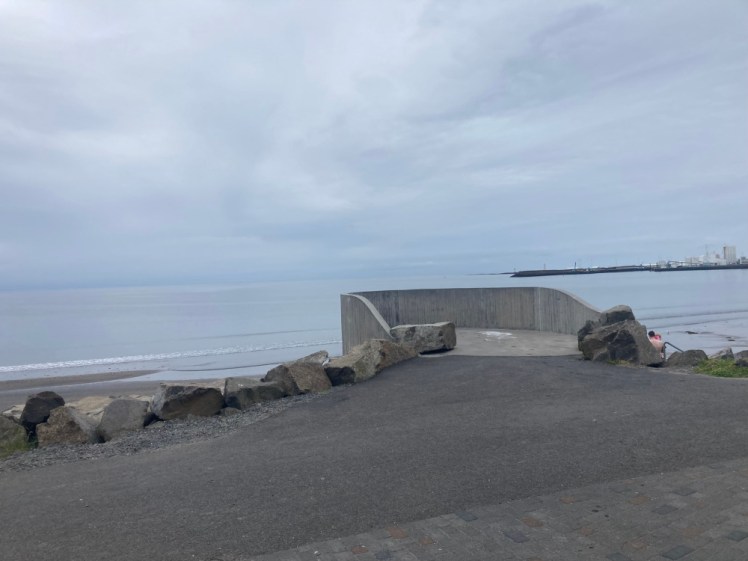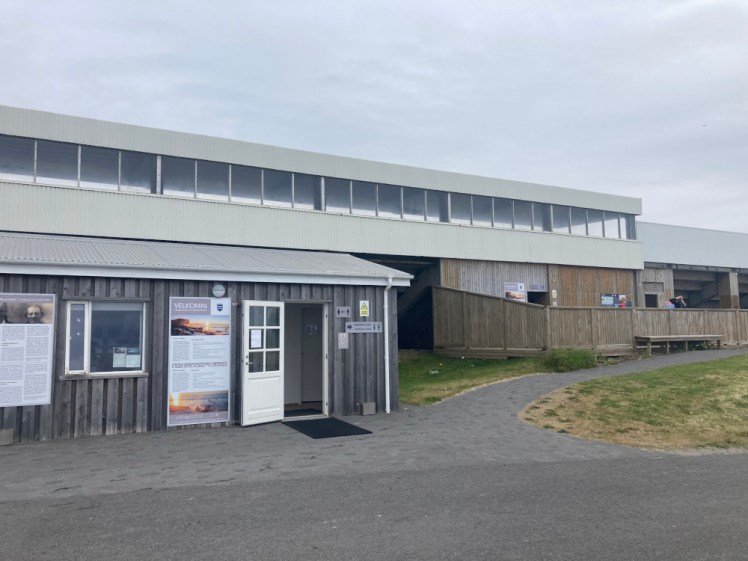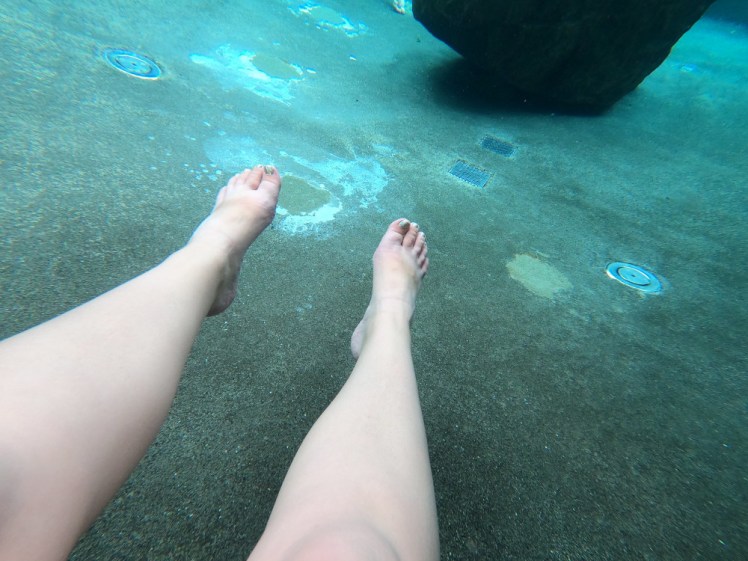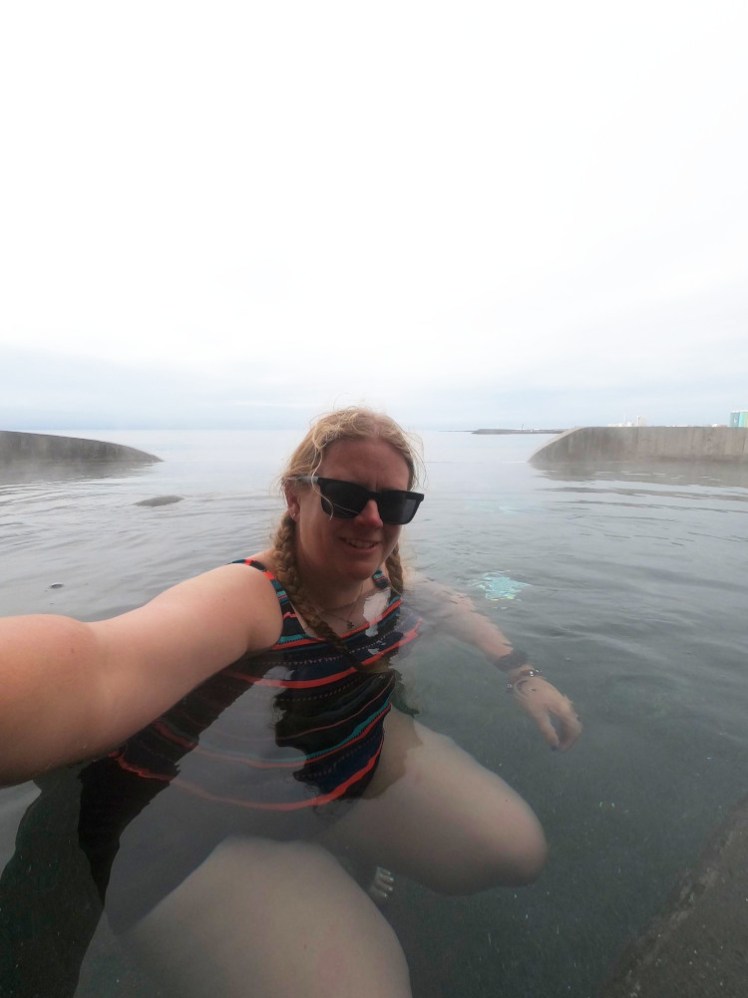I think this is finally the last “what I did in Iceland this summer” post. It’s actually the first thing I did – first after I’d driven three hours to Þingvellir, camped on a chilly cloudy night and dealt with tyres with low pressure. I’d detoured off the Ring Road because I liked the idea of trying out a more “authentic”, slightly less touristy geothermal pool. Guðlaug Baths is right on the seafront. It’s a three-storey concrete tower. The top level is on the promenade, the middle level is a few steps down and houses the pool itself and the lower level is down on the sand. It looks like it has another hot pool but I think it’s just runoff from the main pool, somewhere maybe to wash the worst of the sand off your feet after a sea swim before you run up to warm up in the pool.
Practicalities first: you park next to the big white dome-like thing by the sports centre. I parked out the front of the sports centre but then I had to walk all the way along the road, down Höfðabraut and along the seafront. I measured it – it’s a full kilometre, which is a long way to walk for what I considered the closest car park. Park by the big white building and walk around the corner of the building, past the big trampoline thing and Guðlaug Baths is right ahead.

Next, you go into the cute little hut opposite and pay 500kr. If the hut is closed, the pool is closed. The pool, admittedly, is only closed by a chain hung across the entrance, but when it’s closed, it’s closed. The changing rooms are under the stadium seating – turn round and go in via the wooden decking. There’s information on the wall, making it nice and obvious. It’s very basic changing – I’m not sure there’s even lighting in there. Hang up your stuff or take it with you.

Outside the pool, on the concrete structure, there’s a kind of aluminium “wine rack” for storing your towel. I put my clothes in a drybag and shoved it into another of the pigeonholes. Then there are open-air showers right next to the pool. Finally, enter the pool.

Oh, Guðlaug Baths is gorgeous! Ok, it’s a bit on the Brutalist side. It’s a concrete tower and someone – several someones – have lightly graffitied it. However, if you turn your back on that, you’ve got an amazing view out over Akranes’ huge beach. I was there at low tide, so it was a particularly large beach. If you’re really brave – or possibly really stupid – you can go and swim in the sea here before scurrying back to the hot water.

It’s lovely hot water. It’s even slightly metallic blue. I don’t know if that’s a feature of geothermal water or if there’s something in the pool itself that makes the water look that colour. Anyway, it’s hot and it steams gently and it’s beautiful. It was absolutely what I needed after an early morning, packing up my tent for the first time, a failed first attempt to drive through the Whale Fjord tunnel, a forty-mile drive and three failed attempts to reinflate my low pressure tyre, all before 10am on a Sunday. Just to step into that hot water.

That’s a thing the UK just doesn’t have. If you want hot water when you’re away from home, you have to pay to go to a spa. Our swimming pools, in my experience, are an ok temperature for swimming in but they’re not made for lounging. You do have to pay to go to Guðlaug Baths but 500kr translates to £2.97 / $3.74 / €3.49. You don’t get a lot in the way of facilities for that but then, you’ve barely paid anything. That’s a pretty good price! Iceland has plenty of these small hotpots. Some of them are natural hot springs – some are just muddy puddles in fields, some are funnelled into cow troughs or cheese-making vats (true story) and some are made into proper little hotpots or pools. Maybe I’ll make that my aim for next summer, to find all the nice little roadside hotpots and spend a week popping into as many as possible.

A quick intro to Akranes: with 7,500 inhabitants, it’s a reasonable-sized town for the countryside, although it’s actually really only just across the bay from Reykjavik. It’s a bit of an industrial town. I’ve not mentioned that you can see silos and fairly heavy industry on the seafront from Guðlaug Baths. It has a saddle-shaped mountain, which people enjoy climbing. It has at least three petrol stations. I live in a town of about 9,000 inhabitants and we only have two. It’s a bit of a detour from the Ring Road but not by much, so it’s worth stopping here for a dip. I’ve also camped at the little fjordside campsite – if I hadn’t gone to so much effort to avoid Reykjavik on Saturday afternoon, I would have reached here fairly easily and camped here. Instead, it took nearly three and a half hours to get to Þingvellir and another hour to reach Akranes and I didn’t have the energy for that. If you’re not desperate to avoid the Big Steam (this is my nickname for Reykjavik and I’m hoping it’ll catch on!), you can get here from the airport in under an hour and a half, which makes it a good place to stop on the first night of your Ring Road trip. That is, if your trip doesn’t involve spending a few days in Reykjavik – departing in the morning from Reykjavik, stop here for Guðlaug Baths but then carry on driving. It’s not worth a whole day. It’s also notable because I saw the Northern Lights from the campsite at Akranes – by accident. It was September, I hadn’t realised it was late enough in the year for Lights, I wasn’t looking for them and I was wearing sandals! Don’t take that to mean “Akranes is a great place to look for Northern Lights”, it was just an odd mix of circumstances.

But do take it as “Akranes is a good place to stop for an hour or two to have a dip in Guðlaug Baths”. Oh, and if you want to see it in motion, the vlog with it came out last week. Watch it right now!